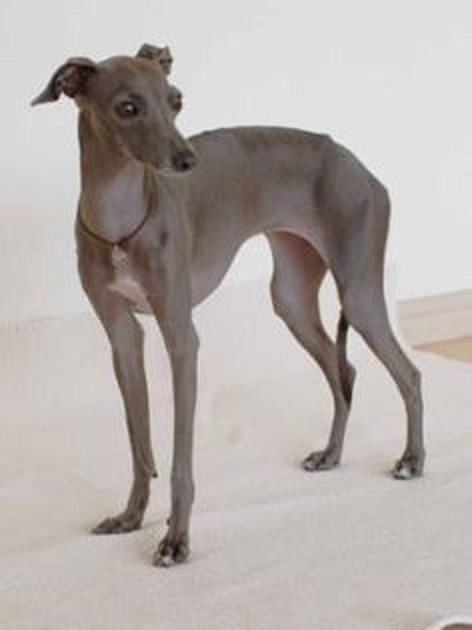
Italian Greyhound

Navigate through the tabs
Navigate through the tabs below to view the breed's info of your interest.
The breed's info is divided in four sections; namely:
the breed's history ,
the breed's main stats ,
the dog's potential health issues
and finally, how the breed scored in 26 different categories.
All the above information should give you a respectively good overview for the dog of your interest.
Dog Breed's Main Info
The Breed's History:
The name of the breed is a reference to the breed's popularity in Renaissance Italy. Mummified dogs very similar to the Italian Greyhound (or small Greyhounds) have been found in Egypt, and pictorials of small Greyhounds have been found in Pompeii, and they were probably the only accepted companion-dog there. Dogs similar to Italian Greyhounds are recorded as having been seen around Emperor Nero's court in Rome in the first century AD.
Although the small dogs are mainly companionship dogs they have in fact been used for hunting rats or mice, often in combination with hunting. It is believed that this was the reason they were bred in the first place by the Greeks.
The Italian Greyhound is the smallest of the family of gazehounds (dogs that hunt by sight). The breed is an old one and is believed to have originated more than 2,000 years ago in the countries now known as Greece and Turkey. This belief is based on the depiction of miniature greyhounds in the early decorative arts of these countries and on the archaeological discovery of small greyhound skeletons.
By the Middle Ages, the breed had become distributed throughout Southern Europe and was later a favorite of the Italians of the sixteenth century, among whom miniature dogs were in great demand. Sadly, though, "designer" breeders tried, and failed, to make the breed even smaller by crossbreeding it with other breeds of dogs.
This only led to mutations with deformed skulls, bulging eyes and dental problems.
The original Italian Greyhound had almost disappeared when groups of breeders got together and managed to return the breed to normal. From this period onward the history of the breed can be fairly well traced as it spread through Europe, arriving in England in the seventeenth century.
Country of Origin:
Italy
Breed Group:
Hound
Height:
1 foot, 1 inch. to 1 foot, 3 inch. (33,02 to 38,10 cm)
Weight:
6 to 15 pounds (2,72 to 6,81 Kg)
Life Span:
14 to 15 years
Potential Health Issues:
Von Willebrand's Disease,
Hip Dysplasia,
Vitreous Degeneration,
Progressive Retinal Atrophy (PRA),
Cataracts,
Hypothyroidism,
Legg-Calve-Perthes Disease,
Patellar Luxation,
Allergies,
Epilepsy,
Cryptorchidism,
Portosystemic Shunt (PSS)
Adaptability
Apartment Living:
First Time Owners:
Sensitivity:
Being Alone:
Cold Weather:
Hot Weather:
Friendliness
Affection With Family:
With Kids:
With Dogs:
With Strangers:
Health and Grooming
Shedding:
Drooling:
Easy To Groom:
Overall Health:
Weight Gain Potential:
Size:
Training
Easiness:
Intelligence:
Mouthiness:
Prey Drive:
Barking or Howling:
Wanderlust:
Need For Exercise
Energy Level:
Intensity:
Exercise Needs:
Playfulness:
Our Mobile Application
Check out Our Mobile Application "Dog Breeds Central"
